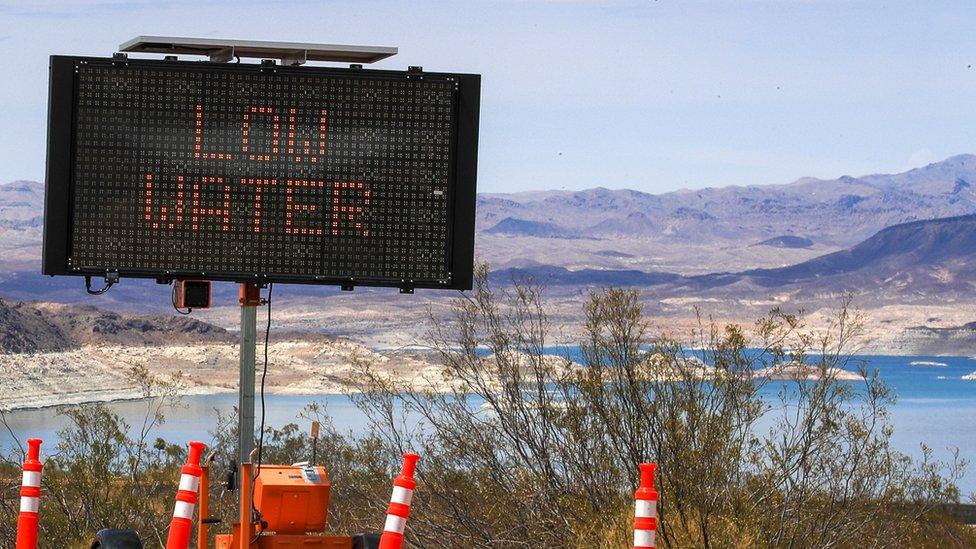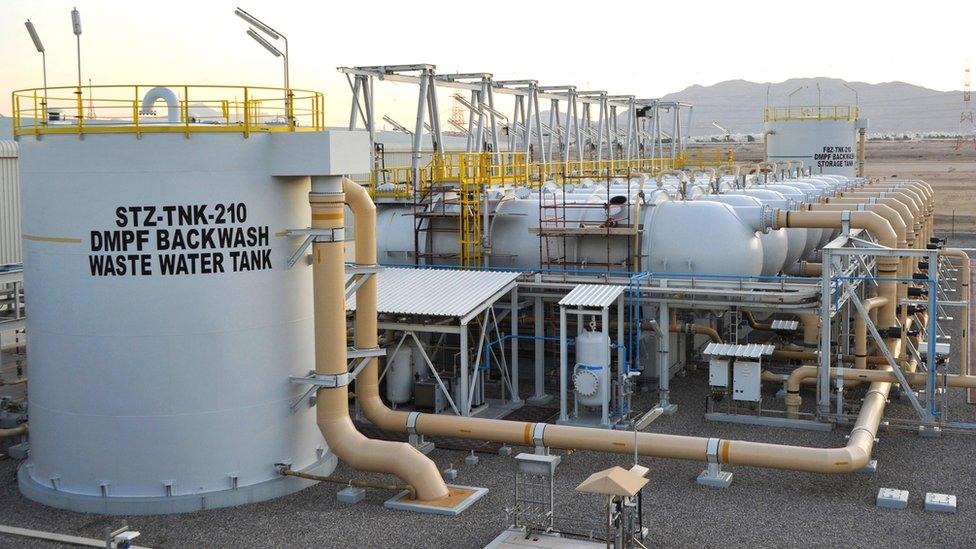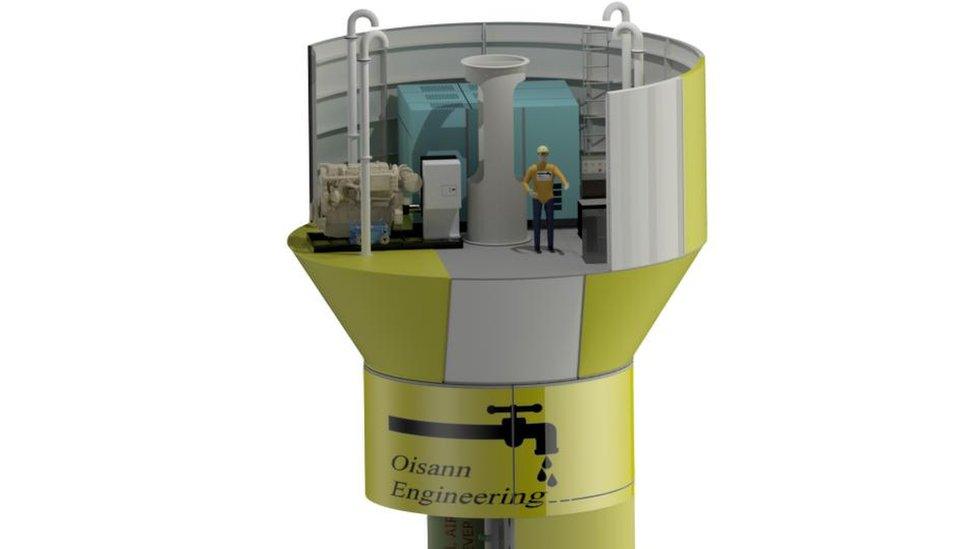Could nuclear desalination plants beat water scarcity?
- Published
- comments

Water scarcity is likely to be a growing problem
There are communities on every continent running short of water, according to the United Nations, external.
Unfortunately, although our planet is swathed by oceans and seas, only a tiny fraction of Earth's water, external - about 2.5% - is fresh, and demand for drinking water is projected to exceed supply by trillions of cubic metres by 2030.
Desalination plants, which remove the salt from seawater, could help supply the fresh water needed.
However, these plants are considered among the most expensive ways of creating drinking water- as they pump large volumes across membranes at high pressure, which is an extremely energy intensive process.
One radical solution could be using floating vessels equipped with desalination systems.
Powered by nuclear reactors, these vessels could travel to islands, or coastlines, struck by drought, bringing with them both clean drinking water and power.
"You could have them moving around on an intermittent basis, filling up tanks," says Mikal Bøe, chief executive of Core Power, which has come up with design for this type of desalination plant.
It may sound far-fetched but the US Navy has provided desalination services, external during disasters in the past, with the help of its nuclear-powered ships, while Russia already has a floating nuclear power station designed to potentially power desalination facilities.
There are already around 20,000 desalination plants worldwide, almost all of which are onshore. The majority are located in Saudi Arabia, the United Arab Emirates and Kuwait, with others in countries including the UK, China, the US, Brazil, South Africa and Australia, to name a few.
But some engineers say it could be cheaper to position this desalination technology offshore, where the seawater can be more easily pumped aboard.

Core Power is developing offshore desalination plants running on nuclear power
For decades, engineers have dreamed of building floating, nuclear powered desalination, external systems.
Core Power want to use a vessel very much like a small container ship, but stack containers on board filled with desalination technology. The nuclear reactor would then lie at the heart of this vessel providing the huge amount of power needed.
The firm's floating nuclear desalination vessels could have varying levels of power output, from five megawatts, up to around 70, Mr Bøe adds. At five megawatts of nuclear power, it could pump out 35,000 cubic metres - or 14 Olympic swimming pools' worth - of freshwater every day.
To take the salt out of saltwater, desalination technology pushes treated seawater across a semi-permeable membrane at pressure. Osmosis, the movement of molecules in liquid across such membranes, removes the minerals, leaving freshwater and a separate, particularly salty water called brine.
There are different versions of this technology and it has become increasingly more efficient over the years. But floating desalination systems remain relatively rare.
Saudi Arabia, however, has just taken delivery of the first of three desalination barges, the largest ever built, external. So, can floating desalination plants take-off?

Floating plants could be cheaper than onshore plants which have to pump seawater significant distances
Oisann Engineering, which has developed a system called Waterfountain, hopes so.
The company has various designs, from large ships to small buoys, but they all work on the same principle, explains chief administrative officer, Kyle Hopkins.
However, the big difference is that instead of using nuclear power, they would all use what's called subsea desalination, a decades-old technology.
"[The technology] was never commercialised because you still need subsea pumps to facilitate taking the water to the surface," says Mr Hopkins. "We removed the pump."
He declines to elaborate as to how this works, beyond saying that the Waterfountain system as a whole takes advantage of the higher pressure on the seafloor to move water around, without incurring high energy costs.
He also mentions that the pipeline from the vessel to shore, where the freshwater must ultimately go, could be raised so that gravity can further assist the water's flow, too, cutting the need for extra power.
Mr Hopkins estimates that the technology could be, roughly, 30% more energy efficient than a traditional onshore desalination facility. The firm is currently building a miniature version of one of its designs and hopes to establish its first commercial installation in the Philippines in 2023.

Water Fountain plans offshore buoys that utilise high pressure on the sea bed
Ideas such as this, and Core Power's design are "promising", says Raya Al-Dadah, head of the Sustainable Energy Technology Laboratory at the University of Birmingham. However, floating desalination has both advantages and disadvantages, she says. There are still challenges in terms of pumping the desalinated water ashore and in finding a workforce with both offshore experience and desalination expertise.
Ultimately, humanity needs more water resources, says Dr Al-Dadah, not least because of the expected effects of climate change, should the world experience more than 1.5C of warming. "This will have a catastrophic impact on water," she says.
Referring to onshore systems, Amy Childress, at the University of Southern California, says that smaller desalination systems could help reduce the environmental impact of the technology.
The highly salty water left after desalination is toxic to marine life and today's desalination facilities produce huge quantities of it - more brine, in fact, than freshwater, external.
Mr Hopkins says that the byproduct expected from the Waterfountain system will not be salty enough to be classed as brine.


The most significant application of floating desalination systems could be in disaster relief, says Greg Pierce, co-director of the University of California Los Angeles Luskin Center for Innovation.
Currently "we're flying and trucking-in bottled water… it's the most inefficient thing possible," he explains, referring to the standard approach to relief efforts. "If floating desalination can address that, I'm all for that."
However, Dr Pierce questions whether it can be made cost-effective enough in other contexts - and notes that there are many other ways of securing clean water supplies. In California, for example, Dr Pierce estimates better water conservation measures could conserve about 30-40% of the water currently consumed in the state.
Communities will probably also turn to measures such as water recycling or treatment of rainwater. But should this still not suffice, desalination, no matter the expense, begins to look inevitable in some parts of the world, he adds.
For now, Core Power's design is merely that, a design. But Mr Bøe hopes that, within a decade, the firm could have a commercial system in operation. The need, he stresses, will be there.